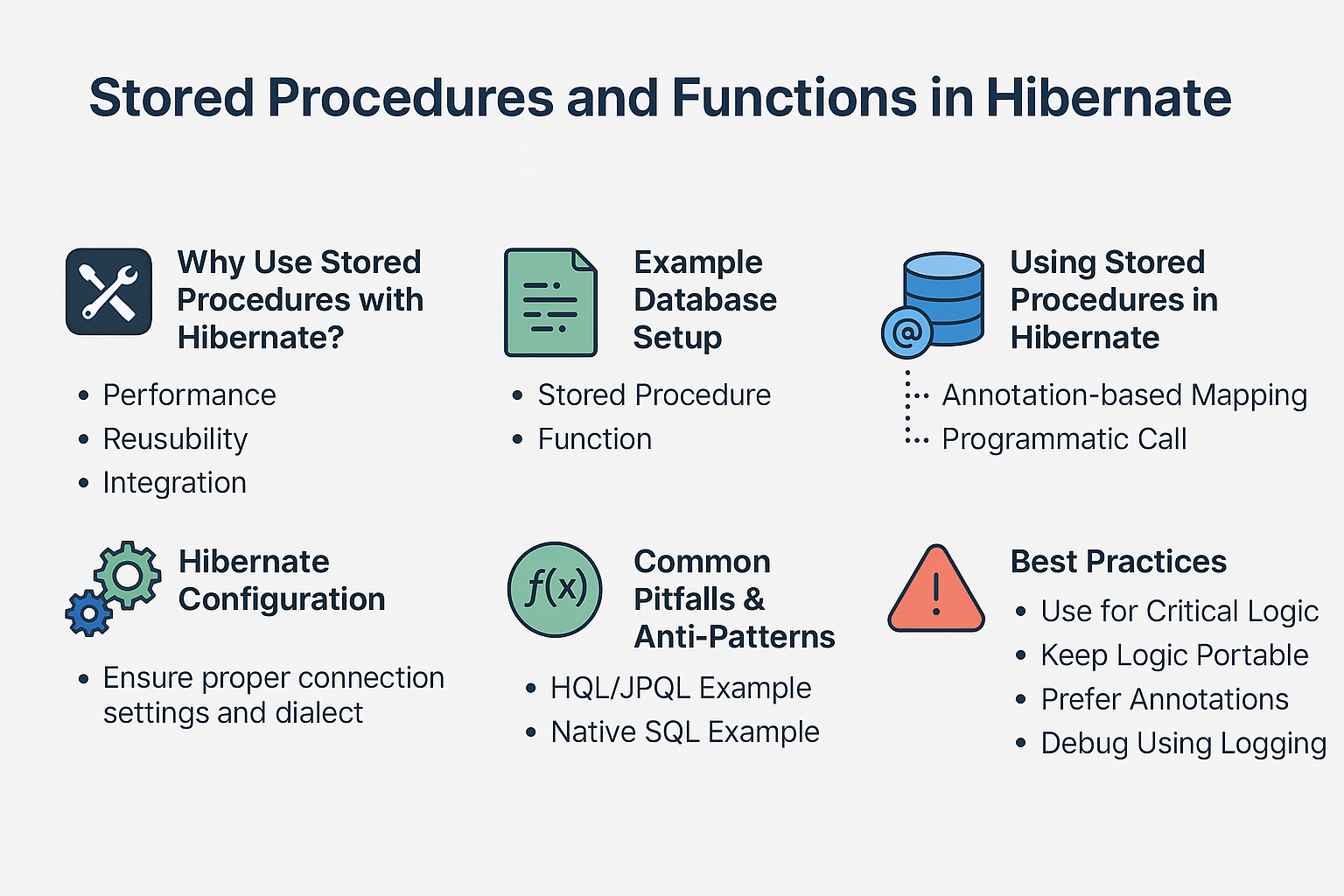Relational databases often use stored procedures and functions to encapsulate complex SQL logic, improve performance, and enforce business rules. Hibernate, as an ORM, provides built-in support to call these procedures and functions seamlessly from Java applications.
Think of stored procedures as pre-written recipes in the database: instead of rewriting the logic every time, you just call the recipe by name. Hibernate bridges the gap by allowing Java applications to invoke these recipes in a standardized way.
In this tutorial, we’ll cover how to use stored procedures and functions in Hibernate, including setup, annotations, query execution, and best practices.
Why Use Stored Procedures with Hibernate?
- Performance: Database executes precompiled SQL faster.
- Reusability: Centralized business logic in the database.
- Security: Restrict direct table access; expose only procedures.
- Integration: Useful in legacy applications with heavy database logic.
Example Database Setup
Stored Procedure
CREATE PROCEDURE get_employees_by_dept(IN dept_name VARCHAR(50))
BEGIN
SELECT * FROM employees WHERE department = dept_name;
END
Function
CREATE FUNCTION count_employees_in_dept(dept_name VARCHAR(50))
RETURNS INT
DETERMINISTIC
BEGIN
DECLARE emp_count INT;
SELECT COUNT(*) INTO emp_count FROM employees WHERE department = dept_name;
RETURN emp_count;
END
Hibernate Configuration
Ensure Hibernate can connect to your database with proper dialects.
spring.datasource.url=jdbc:mysql://localhost:3306/hibernatedb
spring.datasource.username=root
spring.datasource.password=yourpassword
spring.jpa.show-sql=true
spring.jpa.hibernate.ddl-auto=update
spring.jpa.properties.hibernate.dialect=org.hibernate.dialect.MySQL8Dialect
Using Stored Procedures in Hibernate
1. Annotation-Based Mapping
You can map procedures directly to entity queries using @NamedStoredProcedureQuery.
@Entity
@NamedStoredProcedureQuery(
name = "getEmployeesByDept",
procedureName = "get_employees_by_dept",
parameters = {
@StoredProcedureParameter(mode = ParameterMode.IN, name = "dept_name", type = String.class)
},
resultClasses = Employee.class
)
@Table(name = "employees")
public class Employee {
@Id
@GeneratedValue(strategy = GenerationType.IDENTITY)
private Long id;
private String name;
private String department;
private double salary;
}
Executing Stored Procedure
StoredProcedureQuery query = entityManager.createNamedStoredProcedureQuery("getEmployeesByDept");
query.setParameter("dept_name", "IT");
List<Employee> employees = query.getResultList();
2. Programmatic Stored Procedure Call
StoredProcedureQuery query = entityManager
.createStoredProcedureQuery("get_employees_by_dept", Employee.class)
.registerStoredProcedureParameter("dept_name", String.class, ParameterMode.IN)
.setParameter("dept_name", "HR");
List<Employee> result = query.getResultList();
Using Functions in Hibernate
Hibernate allows calling database functions in queries.
HQL/JPQL Example
Query query = entityManager.createQuery(
"SELECT e.name FROM Employee e WHERE function('count_employees_in_dept', e.department) > 5"
);
List<String> names = query.getResultList();
Native SQL Example
Query query = entityManager.createNativeQuery(
"SELECT count_employees_in_dept(:dept)"
);
query.setParameter("dept", "Finance");
int count = (int) query.getSingleResult();
Real-World Use Case: Spring Boot Service
@Service
public class EmployeeService {
@PersistenceContext
private EntityManager entityManager;
public List<Employee> getEmployeesByDept(String dept) {
StoredProcedureQuery query = entityManager
.createStoredProcedureQuery("get_employees_by_dept", Employee.class)
.registerStoredProcedureParameter("dept_name", String.class, ParameterMode.IN)
.setParameter("dept_name", dept);
return query.getResultList();
}
public int countEmployeesByDept(String dept) {
Query query = entityManager.createNativeQuery("SELECT count_employees_in_dept(:dept)");
query.setParameter("dept", dept);
return ((Number) query.getSingleResult()).intValue();
}
}
Common Pitfalls & Anti-Patterns
- Database Lock-In → Stored procedures may reduce portability across databases.
- Overusing Stored Logic → Moves too much business logic into the database.
- Error Handling in DB → Poorly managed exceptions may not propagate to Hibernate.
- Mixing ORM and Native SQL excessively → Breaks abstraction and maintainability.
Best Practices
- Use procedures/functions only for performance-critical or legacy logic.
- Keep most business logic in the application layer for portability.
- Prefer annotations for reusable mappings.
- Test stored procedures independently in the DB before Hibernate integration.
- Use Hibernate’s logging (
show_sql) to debug execution.
📌 Hibernate Version Notes
Hibernate 5.x
- Uses
javax.persistence. - Stored procedures supported with
@NamedStoredProcedureQuery. - Function calls required native SQL.
Hibernate 6.x
- Migrated to
jakarta.persistence. - Improved
function()support in HQL/JPQL. - Enhanced support for database-specific functions.
- Cleaner integration with Spring Boot 3.x.
Conclusion & Key Takeaways
- Stored procedures and functions improve performance and encapsulate logic.
- Hibernate integrates with them using annotations or programmatic APIs.
- Use them wisely to balance performance vs maintainability.
- Hibernate 6 improves function integration for modern databases.
FAQ: Expert-Level Questions
Q1: What’s the difference between Hibernate and JPA?
Hibernate is a JPA implementation with extended features like stored procedure and function support.
Q2: How does Hibernate caching improve performance?
By reducing database hits with first-level and second-level caching.
Q3: What are the drawbacks of eager fetching?
It loads unnecessary data, leading to performance issues.
Q4: How do I solve the N+1 select problem in Hibernate?
Use fetch joins, @BatchSize, or entity graphs.
Q5: Can I use Hibernate without Spring?
Yes, Hibernate works standalone with stored procedure support.
Q6: What’s the best strategy for inheritance mapping?
Depends on requirements: SINGLE_TABLE, JOINED, or TABLE_PER_CLASS.
Q7: How does Hibernate handle composite keys?
With @Embeddable + @EmbeddedId or @IdClass.
Q8: How is Hibernate 6 different from Hibernate 5?
Hibernate 6 uses jakarta.persistence, improves function handling, and enhances SQL support.
Q9: Is Hibernate suitable for microservices?
Yes, but microservices often avoid stored procedures for portability; prefer service-driven logic.
Q10: When should I not use Hibernate?
Avoid Hibernate when performance-critical applications need low-level SQL optimizations.
